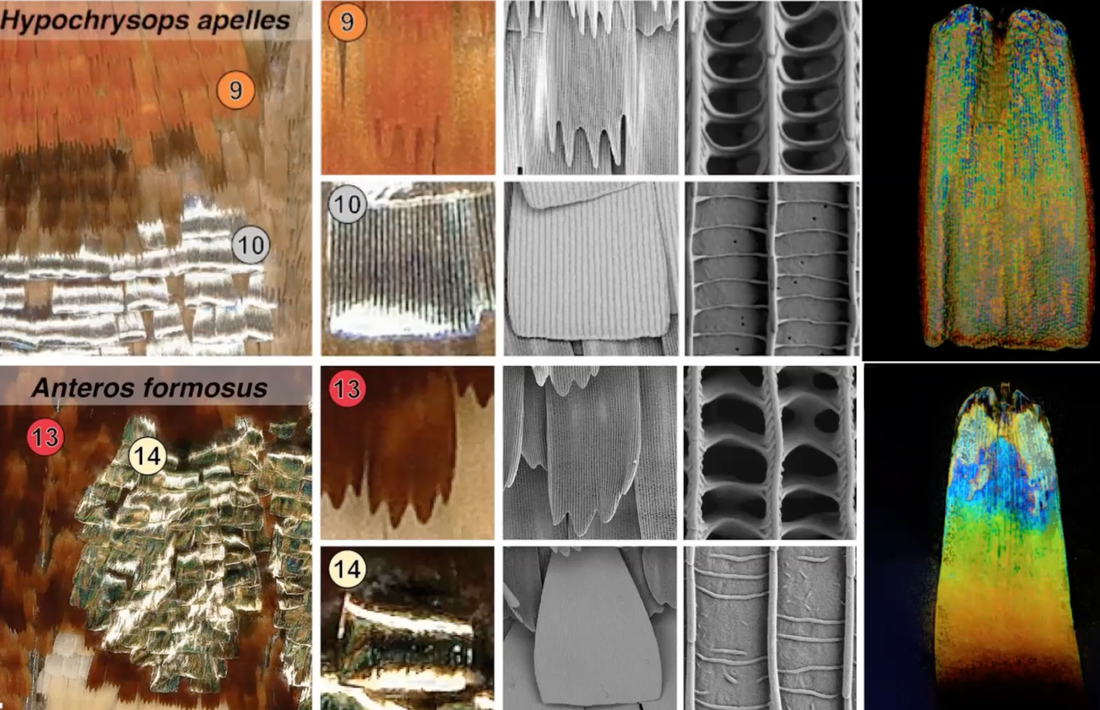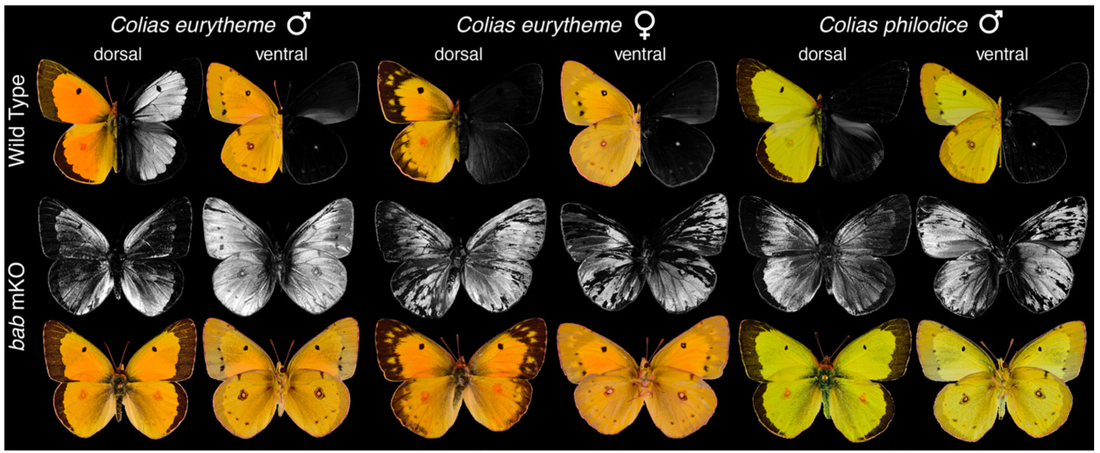|
written by: Eva Perry and Jonna Sanders Dr. Joe Hanly’s research on speciation genomics in Colias Butterflies (sulphurs) of North America is the very embodiment of this phrase, through his investigation of wing patterns in the evolution and diversity of these butterflies. A post-doctoral researcher at George Washington University, Dr. Hanly’s research for the past several years has focused on understanding the relationship between genotypes to phenotypes, or rather, how specific genomes, through the processes of development and evolutionary selection, lead to specific phenotype expressions in wing patterns in Colias butterflies. Butterfly wings are covered in thousands of scales, each one an individual cell that differentiates during the early pupal stages of metamorphosis. Scale differentiation is controlled by specific regions of the developing butterfly’s genome, which determines pigment type and quantity in each scale based on its location on the wing. Pigment alone, however, is not enough – the structural details of the scale are an essential component to determining its color. Intricately arranged filaments of actin (a multi-functional protein) joined by ridge-like deposits of chitin create structural patterns that interact with light in different ways. This creates a remarkable amount of variation – even mirror-like reflectance1 (Figure 1).  Figure 1: Variation in the shape of butterfly scales shows how color is determined by structure1. Note that the “metallic” scale structures in the two different species are strikingly similar: wide and flat, with filled-in spaces. The reflectance of these scales is different from a mirror, in that they reflect all light frequencies while remaining very thin. This is possible because different parts of the scale are reflecting different colors of light (instead of all at once), giving the perception of a mirror. During the seminar, Dr. Hanly described his and his colleagues’ research using CRISPR mosaic gene knock-out techniques, whereby the removal of a specific genomic region can alter the phenotypic expression of the scale patterns on butterfly wings. Hanly’s research at George Washington University focuses upon the differences between two Colias butterfly species, the common sulfur (Colias philodice) and the orange sulfur (Colias eurytheme), which phenotypically diverged due to feeding preferences between C. eurytheme in the Western USA, and C. philodice in the Eastern USA. In comparing the wing pattern variations between C. philodice and C. eurytheme species, male C. eurytheme exhibit ultraviolet reflectance compared to C. philodice males, and females of both species. This UV reflectance is the result of scale structures that have ridges with lamellae, are uniformly spaced to interact with ultraviolet wavelengths. Ultraviolet light is trapped in these structures and is reflected back, whereas other frequencies of light are not. This system is an excellent model to test the genetic basis of sexually dimorphic wing pattern variation, as C. eurytheme and C. philodice are capable of hybridizing with each other. With regard to mating behaviors, the female Colias butterflies are more selective than the males2. In Colias butterflies, sexual traits such as preference, fertility, pheremone expressions, size determination, and color effects are mapped to the same sex chromosome. C. philodice selects conspecific mates based upon olfactory clues, whereas C. eurytheme selects for traits based on ultraviolet iridescence. Like birds, female butterflies are heterogametic (ZW) while the males are homogametic (ZZ). For the two Colias species studied by Dr. Hanly, the only individuals that express UV reflectance on the dorsal wings are C. eurytheme males; thus the trait is assumed to be homozygous recessive. While females with a C. eurytheme Z chromosome do not express UV reflectance on their wings, they do show a preference for males that express it, suggesting that the genetic determination of mate preference is located on the same chromosome as UV reflectance3. All crosses of these two species are capable of producing offspring, but if a C. eurytheme female mates with a C. philodice male, the female offspring (an individual with a C. eurytheme W sex chromosome and a C. philodice Z sex chromosome) will be sterile. This results in strong selection pressure for females to select males that display UV reflectance. To begin the process of determining which gene or genes on the sex chromosome determine UV reflectance, Dr. Hanly and his colleagues collected C. eurytheme and C. philodice butterflies from Hedgeapple Farm in Buckeystown, Maryland. They crossbred both species to obtain hybrids and sequenced the genomes, focusing on regions where both recombination and divergence were high. High recombination and high divergence indicate that selection is likely happening. Their results indicated a region of twenty different genes that could be responsible for UV reflectance, including bab (bric à brac), a gene responsible for repressing male-specific traits in the model organism Drosophila4. Could bab be associated with UV reflectance in male C. eurytheme? A closer look at the genetic expression in their scale cells showed that bab is repressed in scales with UV reflectance, and expressed in scale cells without. This seemed to support their hypothesis that bab repression results in UV reflectance, so to test it, a CRISPR-facilitated knockout of bab was used on C. eurytheme males, C. philodice males, and also C. eurytheme females5. All three groups exhibited UV reflectance in wing scales when bab was fully repressed (Figure 2), which indicates it is highly likely that bab is the gene responsible for determining UV reflectance in Colias. Dr. Hanly and his collaborators’ remarkable research on gene expression of butterfly wing scale iridescence clearly highlights the role of specific genes in evolutionary changes between C. philodice and C. eurytheme. These genomic markers, to which Dr. Hanly’s research elucidates, are responsible for controlling the repression of ultraviolet reflectance, and demonstrate important links between the role of iridescence in mating behaviors and speciation differences between the two groups. Future research is needed on UV reflectance as an evolutionary marker of bab, and the precise mechanism of its role in repression of UV scales in Colias butterflies.
Works Cited:
Authors: Eva Perry is a second year PhD student in the Burghardt Lab. Her research addresses urban plant-insect ecology, with particular interest in the interactions between environment, herbivory, and tree phytochemistry. Jonna Sanders is a first year PhD student currently on rotation in the Lamp Lab. Her research interests include Hymenoptera, use of parasitoids in pest management, as well as novel approaches to crop rotation. Comments are closed.
|
Categories
All
Archives
June 2024
|
Department of Entomology
University of Maryland
4112 Plant Sciences Building
College Park, MD 20742-4454
USA
Telephone: 301.405.3911
Fax: 301.314.9290
University of Maryland
4112 Plant Sciences Building
College Park, MD 20742-4454
USA
Telephone: 301.405.3911
Fax: 301.314.9290


 RSS Feed
RSS Feed




